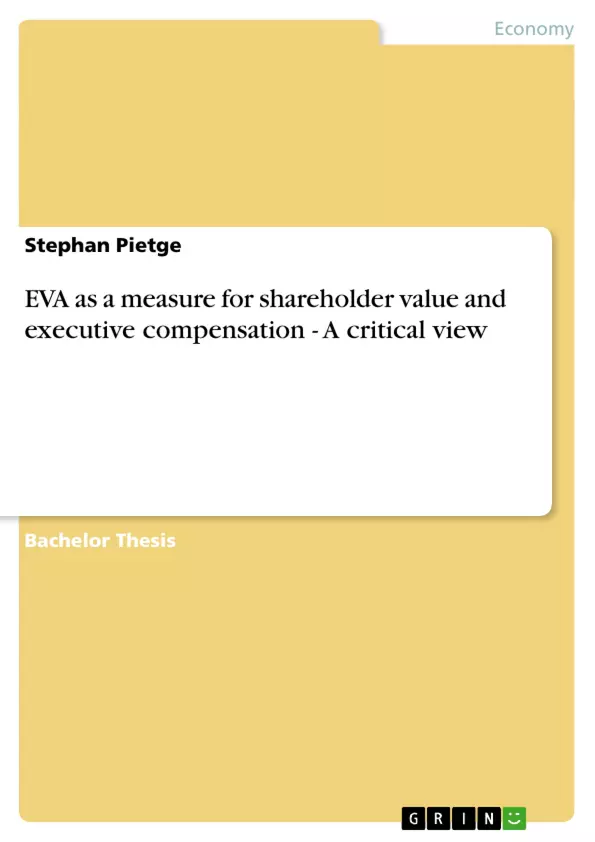For several decades academics have been looking for an efficient performance measure, which not only reflects the effectiveness and efficiency of the firm, but also aligns manager′s and shareholder′s interests. Even though many studies question the merit of a single measure for overall firm performance, Stern and Stewart claim to have solved the puzzle with a method labeled Economic Value Added (EVA).
This paper examines two aspects: First, EVA′s predicting power regarding stock returns and second, its impact on management behavior as an element of executive compensation.
At first glance, Stern and Stewart seem to be right. During the early 1990s their approach gained tremendous popularity, reflected by dozens of anecdotal success stories. Though EVA′s demand of integrating a total capital charge is appealing, the concept is by no means new. The framework of residual income (economic profit), which has been around for decades, also requires a charge for equity capital. Further, some scholars criticize the use of accounting adjustments in order to calculate EVA and its ability to capture performance at the divisional level.
So far there is no independent empirical evidence that EVA is superior to accounting measures in predicting stock returns. Some studies even question EVA′s incremental value regarding executive compensation by stating that economic profit is doing as good a job.
Consequently, it is tempting to doubt that Economic Value Added indeed adds any value.
Inhaltsverzeichnis (Table of Contents)
- Abstract
- Acknowledgements
- Statement of Original Work
- Abbreviations
- Chapter 1: Introduction
- 1.1 Motivation
- 1.2 Problem Definition
- 1.3 Research Objectives
- 1.4 Research Methodology
- 1.5 Structure of the Paper
- Chapter 2: Economic Value Added - Concepts and Calculations
- 2.1 Introduction
- 2.2 The Theoretical Framework
- 2.2.1 Residual Income
- 2.2.2 Economic Profit
- 2.3 The EVA Framework
- 2.4 Criticisms of the EVA Concept
- 2.4.1 Accounting Adjustments
- 2.4.2 Calculation of the Cost of Capital
- 2.4.3 Divisional Level Performance
- 2.4.4 The Use of EVA for Incentive Compensation
- Chapter 3: The Impact of EVA on Firm Value
- 3.1 Introduction
- 3.2 Theoretical Framework
- 3.3 Empirical Studies on EVA
- 3.3.1 Studies Focused on Stock Returns
- 3.3.2 Studies Focusing on the Relationship between EVA and Market Value
- Chapter 4: EVA and Executive Compensation
- 4.1 Introduction
- 4.2 Theoretical Framework
- 4.3 Empirical Studies on EVA and Executive Compensation
- 4.3.1 Studies on EVA as a Performance Measure
- 4.3.2 Studies on the Influence of EVA on Executive Compensation
- Chapter 5: Conclusion
Zielsetzung und Themenschwerpunkte (Objectives and Key Themes)
This paper examines the effectiveness of economic value added (EVA) as a performance measure for both shareholder value and executive compensation. The study aims to critically assess EVA's ability to predict stock returns and its influence on managerial behavior.
- The theoretical foundation of EVA and its relationship to other performance measures, such as residual income and economic profit.
- The impact of EVA on firm value, considering both empirical studies on stock returns and market value.
- The influence of EVA on executive compensation, examining its use as a performance measure and its impact on managerial incentives.
- Criticisms of EVA, including its reliance on accounting adjustments, the calculation of the cost of capital, and its ability to capture divisional performance.
- The overall value and effectiveness of EVA as a performance measure, considering both its potential benefits and drawbacks.
Zusammenfassung der Kapitel (Chapter Summaries)
This section provides a summary of each chapter.
- Chapter 1: Introduction Introduces the topic of EVA and its potential benefits and limitations as a performance measure. It defines the research objectives, outlining the key questions to be addressed. This chapter also presents the research methodology and the structure of the paper.
- Chapter 2: Economic Value Added - Concepts and Calculations Discusses the theoretical framework of EVA, explaining its relationship to residual income and economic profit. It delves into the calculations involved in calculating EVA and explores criticisms surrounding the concept, such as accounting adjustments, the cost of capital, divisional performance, and the use of EVA for incentive compensation.
- Chapter 3: The Impact of EVA on Firm Value Examines the theoretical and empirical evidence regarding the impact of EVA on firm value. It discusses studies focusing on stock returns and market value, providing an overview of the existing research findings.
- Chapter 4: EVA and Executive Compensation Analyzes the relationship between EVA and executive compensation, exploring its use as a performance measure and its impact on managerial incentives. This chapter presents empirical studies investigating the influence of EVA on executive compensation and its overall effectiveness in aligning managerial and shareholder interests.
Schlüsselwörter (Keywords)
This paper focuses on the use of economic value added (EVA) as a measure for shareholder value and executive compensation. The central concepts explored include residual income, economic profit, firm value, stock returns, executive compensation, and managerial incentives. Key aspects of EVA, such as accounting adjustments, the cost of capital, and its ability to capture divisional performance, are also discussed.
- Quote paper
- Stephan Pietge (Author), 2003, EVA as a measure for shareholder value and executive compensation - A critical view, Munich, GRIN Verlag, https://www.grin.com/document/16993



